Positive Psychology Intervention in PTSD: A Resilience Case Study
VerifiedAdded on 2023/06/04
|7
|2026
|149
Case Study
AI Summary
This case study examines the application of positive psychology interventions, particularly Cognitive Behavioral Therapy (CBT) and resilience-building techniques, in addressing Post-Traumatic Stress Disorder (PTSD) in a 14-year-old Syrian girl named Ameerah. Ameerah experienced significant trauma, including a bomb blast, loss of her brother, and displacement to the UK. The study reviews literature on resilience interventions, highlighting their role in fostering self-awareness, mindfulness, self-care, positive relationships, and purpose. It discusses how interventions like CBT, stress inoculation therapy, and acceptance and commitment therapy can help Ameerah challenge negative thought patterns, cope with triggers, and accept past events. The case study also acknowledges the limitations of these interventions, such as difficulty in identifying root causes and the potential for relapse. It emphasizes the importance of implementing interventions at various levels, including school, family, and individual settings, to promote comprehensive recovery and improve Ameerah's overall well-being. Desklib provides access to similar case studies and solved assignments for students.
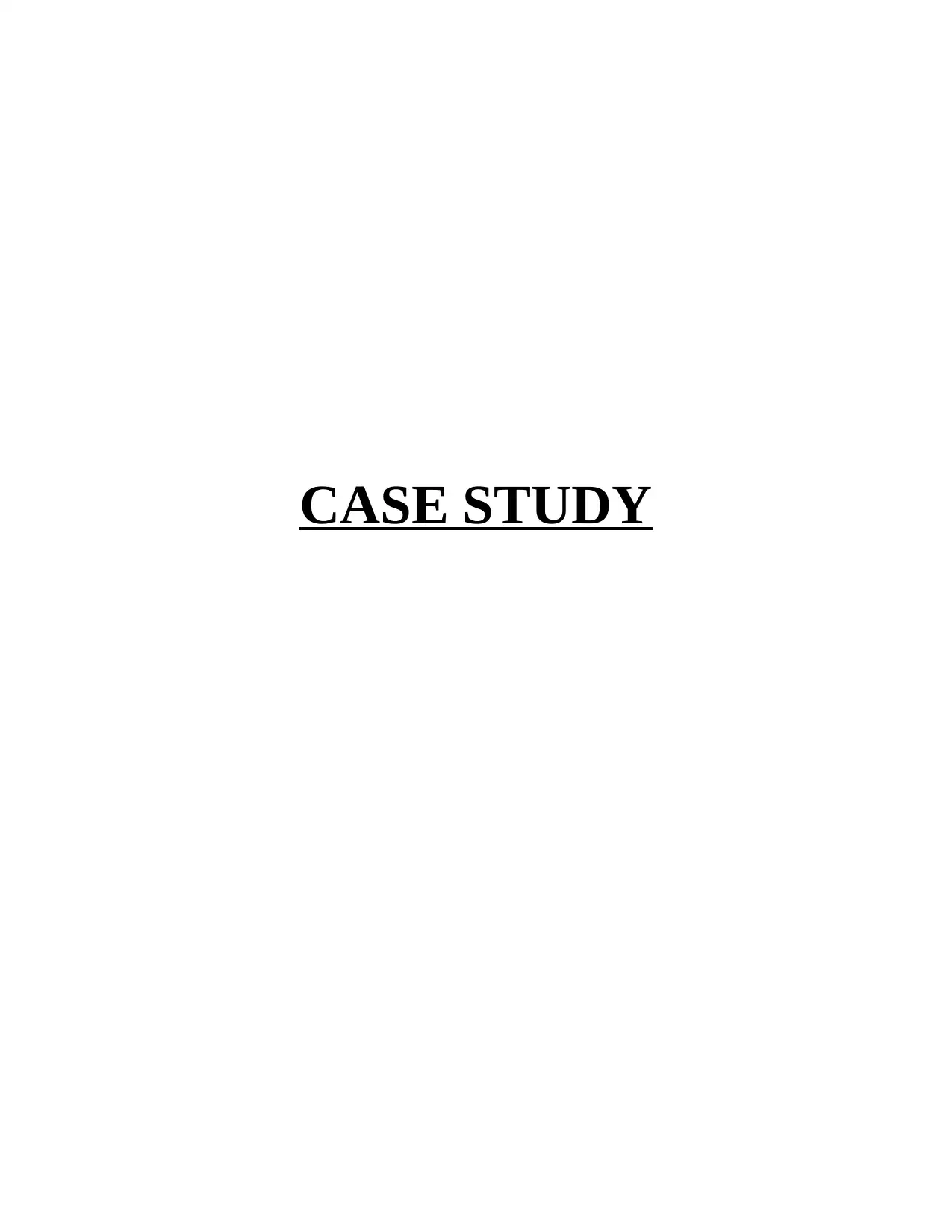
CASE STUDY
Paraphrase This Document
Need a fresh take? Get an instant paraphrase of this document with our AI Paraphraser
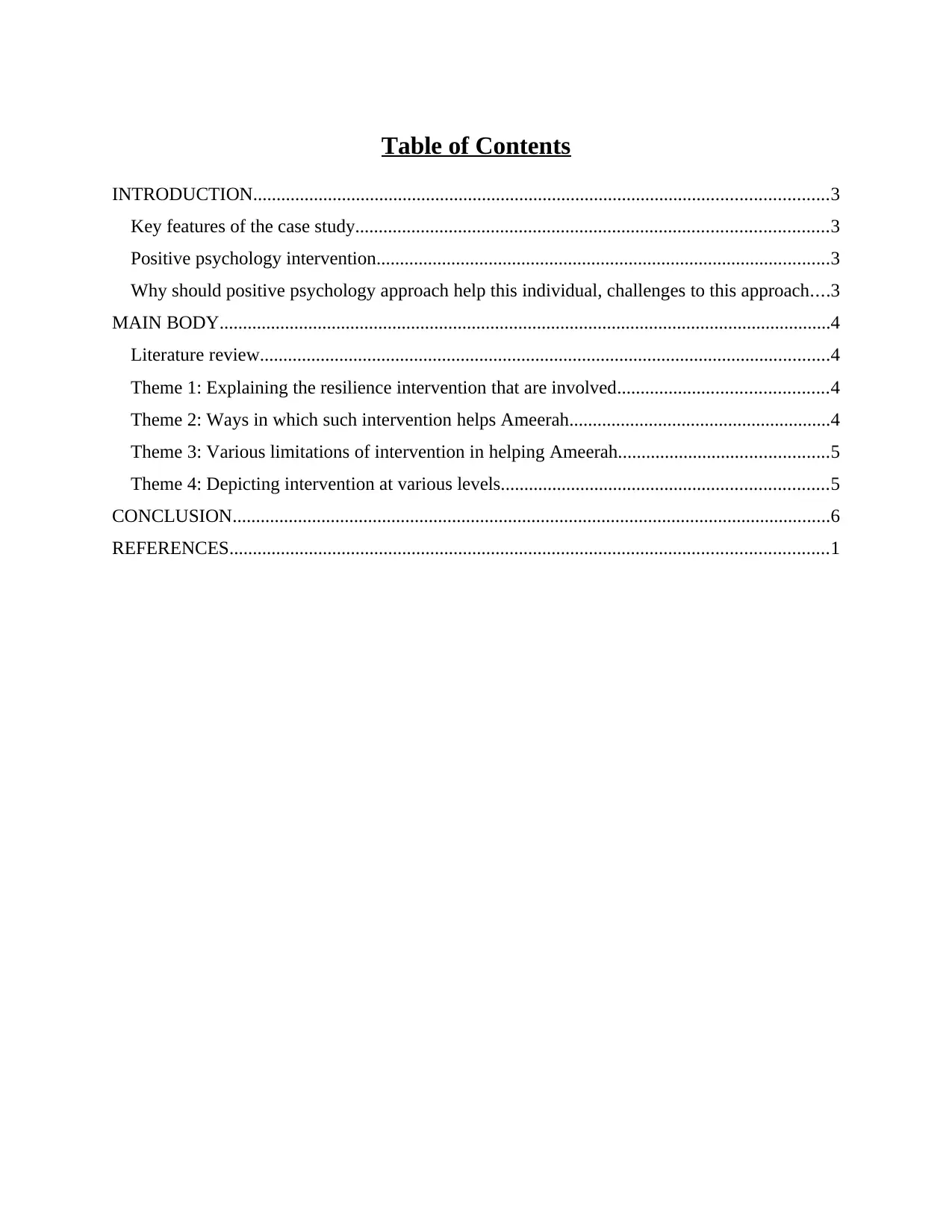
Table of Contents
INTRODUCTION...........................................................................................................................3
Key features of the case study.....................................................................................................3
Positive psychology intervention.................................................................................................3
Why should positive psychology approach help this individual, challenges to this approach....3
MAIN BODY...................................................................................................................................4
Literature review..........................................................................................................................4
Theme 1: Explaining the resilience intervention that are involved.............................................4
Theme 2: Ways in which such intervention helps Ameerah........................................................4
Theme 3: Various limitations of intervention in helping Ameerah.............................................5
Theme 4: Depicting intervention at various levels......................................................................5
CONCLUSION................................................................................................................................6
REFERENCES................................................................................................................................1
INTRODUCTION...........................................................................................................................3
Key features of the case study.....................................................................................................3
Positive psychology intervention.................................................................................................3
Why should positive psychology approach help this individual, challenges to this approach....3
MAIN BODY...................................................................................................................................4
Literature review..........................................................................................................................4
Theme 1: Explaining the resilience intervention that are involved.............................................4
Theme 2: Ways in which such intervention helps Ameerah........................................................4
Theme 3: Various limitations of intervention in helping Ameerah.............................................5
Theme 4: Depicting intervention at various levels......................................................................5
CONCLUSION................................................................................................................................6
REFERENCES................................................................................................................................1
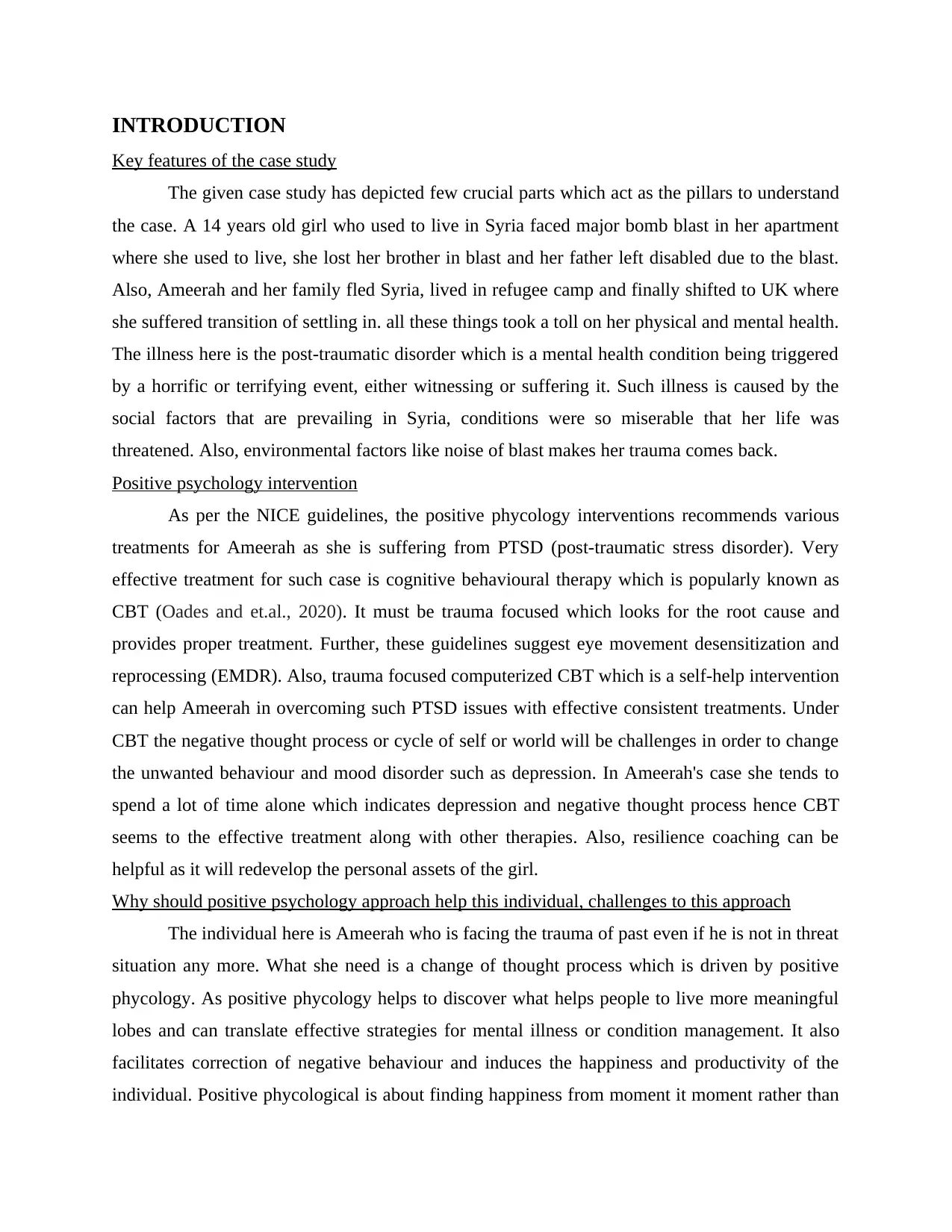
INTRODUCTION
Key features of the case study
The given case study has depicted few crucial parts which act as the pillars to understand
the case. A 14 years old girl who used to live in Syria faced major bomb blast in her apartment
where she used to live, she lost her brother in blast and her father left disabled due to the blast.
Also, Ameerah and her family fled Syria, lived in refugee camp and finally shifted to UK where
she suffered transition of settling in. all these things took a toll on her physical and mental health.
The illness here is the post-traumatic disorder which is a mental health condition being triggered
by a horrific or terrifying event, either witnessing or suffering it. Such illness is caused by the
social factors that are prevailing in Syria, conditions were so miserable that her life was
threatened. Also, environmental factors like noise of blast makes her trauma comes back.
Positive psychology intervention
As per the NICE guidelines, the positive phycology interventions recommends various
treatments for Ameerah as she is suffering from PTSD (post-traumatic stress disorder). Very
effective treatment for such case is cognitive behavioural therapy which is popularly known as
CBT (Oades and et.al., 2020). It must be trauma focused which looks for the root cause and
provides proper treatment. Further, these guidelines suggest eye movement desensitization and
reprocessing (EMDR). Also, trauma focused computerized CBT which is a self-help intervention
can help Ameerah in overcoming such PTSD issues with effective consistent treatments. Under
CBT the negative thought process or cycle of self or world will be challenges in order to change
the unwanted behaviour and mood disorder such as depression. In Ameerah's case she tends to
spend a lot of time alone which indicates depression and negative thought process hence CBT
seems to the effective treatment along with other therapies. Also, resilience coaching can be
helpful as it will redevelop the personal assets of the girl.
Why should positive psychology approach help this individual, challenges to this approach
The individual here is Ameerah who is facing the trauma of past even if he is not in threat
situation any more. What she need is a change of thought process which is driven by positive
phycology. As positive phycology helps to discover what helps people to live more meaningful
lobes and can translate effective strategies for mental illness or condition management. It also
facilitates correction of negative behaviour and induces the happiness and productivity of the
individual. Positive phycological is about finding happiness from moment it moment rather than
Key features of the case study
The given case study has depicted few crucial parts which act as the pillars to understand
the case. A 14 years old girl who used to live in Syria faced major bomb blast in her apartment
where she used to live, she lost her brother in blast and her father left disabled due to the blast.
Also, Ameerah and her family fled Syria, lived in refugee camp and finally shifted to UK where
she suffered transition of settling in. all these things took a toll on her physical and mental health.
The illness here is the post-traumatic disorder which is a mental health condition being triggered
by a horrific or terrifying event, either witnessing or suffering it. Such illness is caused by the
social factors that are prevailing in Syria, conditions were so miserable that her life was
threatened. Also, environmental factors like noise of blast makes her trauma comes back.
Positive psychology intervention
As per the NICE guidelines, the positive phycology interventions recommends various
treatments for Ameerah as she is suffering from PTSD (post-traumatic stress disorder). Very
effective treatment for such case is cognitive behavioural therapy which is popularly known as
CBT (Oades and et.al., 2020). It must be trauma focused which looks for the root cause and
provides proper treatment. Further, these guidelines suggest eye movement desensitization and
reprocessing (EMDR). Also, trauma focused computerized CBT which is a self-help intervention
can help Ameerah in overcoming such PTSD issues with effective consistent treatments. Under
CBT the negative thought process or cycle of self or world will be challenges in order to change
the unwanted behaviour and mood disorder such as depression. In Ameerah's case she tends to
spend a lot of time alone which indicates depression and negative thought process hence CBT
seems to the effective treatment along with other therapies. Also, resilience coaching can be
helpful as it will redevelop the personal assets of the girl.
Why should positive psychology approach help this individual, challenges to this approach
The individual here is Ameerah who is facing the trauma of past even if he is not in threat
situation any more. What she need is a change of thought process which is driven by positive
phycology. As positive phycology helps to discover what helps people to live more meaningful
lobes and can translate effective strategies for mental illness or condition management. It also
facilitates correction of negative behaviour and induces the happiness and productivity of the
individual. Positive phycological is about finding happiness from moment it moment rather than
⊘ This is a preview!⊘
Do you want full access?
Subscribe today to unlock all pages.

Trusted by 1+ million students worldwide
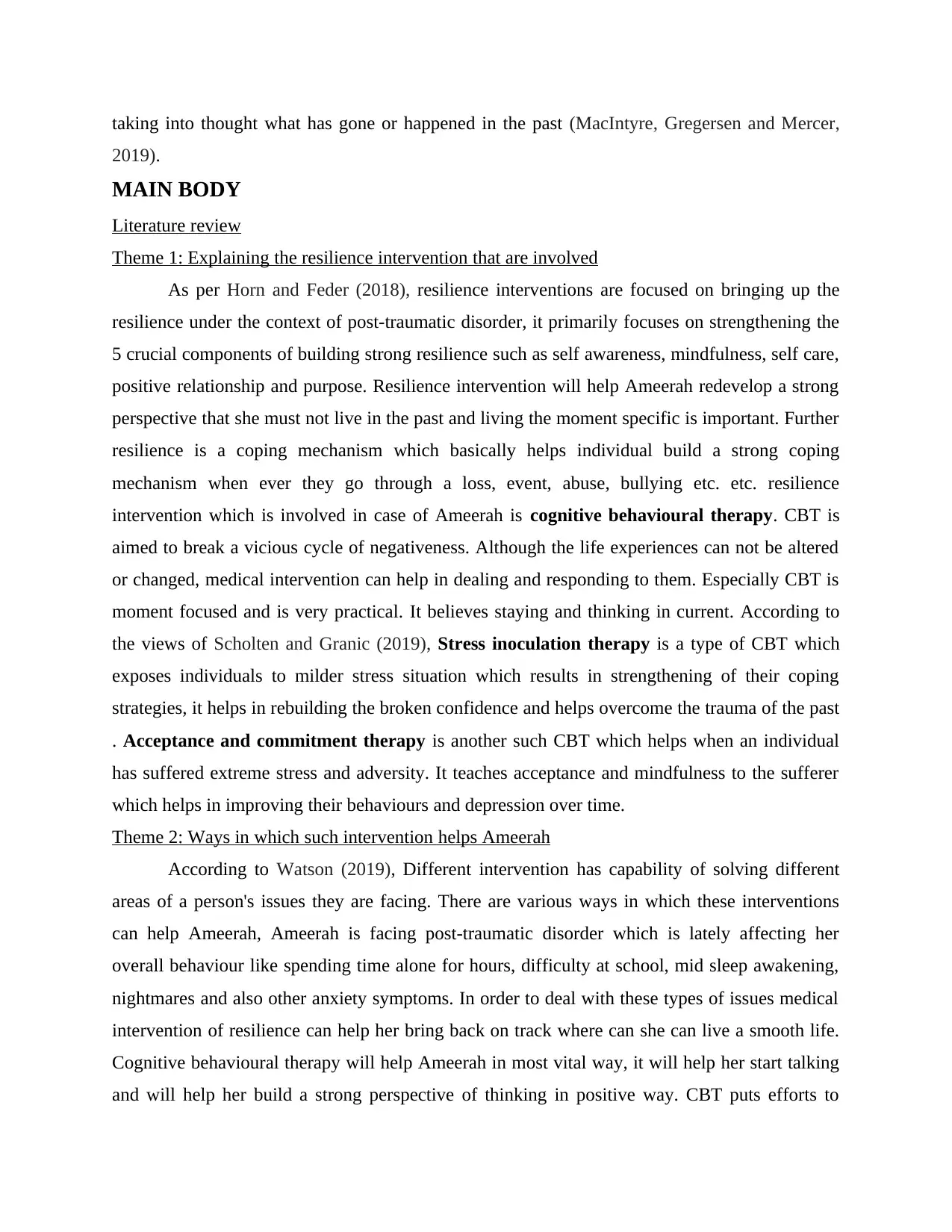
taking into thought what has gone or happened in the past (MacIntyre, Gregersen and Mercer,
2019).
MAIN BODY
Literature review
Theme 1: Explaining the resilience intervention that are involved
As per Horn and Feder (2018), resilience interventions are focused on bringing up the
resilience under the context of post-traumatic disorder, it primarily focuses on strengthening the
5 crucial components of building strong resilience such as self awareness, mindfulness, self care,
positive relationship and purpose. Resilience intervention will help Ameerah redevelop a strong
perspective that she must not live in the past and living the moment specific is important. Further
resilience is a coping mechanism which basically helps individual build a strong coping
mechanism when ever they go through a loss, event, abuse, bullying etc. etc. resilience
intervention which is involved in case of Ameerah is cognitive behavioural therapy. CBT is
aimed to break a vicious cycle of negativeness. Although the life experiences can not be altered
or changed, medical intervention can help in dealing and responding to them. Especially CBT is
moment focused and is very practical. It believes staying and thinking in current. According to
the views of Scholten and Granic (2019), Stress inoculation therapy is a type of CBT which
exposes individuals to milder stress situation which results in strengthening of their coping
strategies, it helps in rebuilding the broken confidence and helps overcome the trauma of the past
. Acceptance and commitment therapy is another such CBT which helps when an individual
has suffered extreme stress and adversity. It teaches acceptance and mindfulness to the sufferer
which helps in improving their behaviours and depression over time.
Theme 2: Ways in which such intervention helps Ameerah
According to Watson (2019), Different intervention has capability of solving different
areas of a person's issues they are facing. There are various ways in which these interventions
can help Ameerah, Ameerah is facing post-traumatic disorder which is lately affecting her
overall behaviour like spending time alone for hours, difficulty at school, mid sleep awakening,
nightmares and also other anxiety symptoms. In order to deal with these types of issues medical
intervention of resilience can help her bring back on track where can she can live a smooth life.
Cognitive behavioural therapy will help Ameerah in most vital way, it will help her start talking
and will help her build a strong perspective of thinking in positive way. CBT puts efforts to
2019).
MAIN BODY
Literature review
Theme 1: Explaining the resilience intervention that are involved
As per Horn and Feder (2018), resilience interventions are focused on bringing up the
resilience under the context of post-traumatic disorder, it primarily focuses on strengthening the
5 crucial components of building strong resilience such as self awareness, mindfulness, self care,
positive relationship and purpose. Resilience intervention will help Ameerah redevelop a strong
perspective that she must not live in the past and living the moment specific is important. Further
resilience is a coping mechanism which basically helps individual build a strong coping
mechanism when ever they go through a loss, event, abuse, bullying etc. etc. resilience
intervention which is involved in case of Ameerah is cognitive behavioural therapy. CBT is
aimed to break a vicious cycle of negativeness. Although the life experiences can not be altered
or changed, medical intervention can help in dealing and responding to them. Especially CBT is
moment focused and is very practical. It believes staying and thinking in current. According to
the views of Scholten and Granic (2019), Stress inoculation therapy is a type of CBT which
exposes individuals to milder stress situation which results in strengthening of their coping
strategies, it helps in rebuilding the broken confidence and helps overcome the trauma of the past
. Acceptance and commitment therapy is another such CBT which helps when an individual
has suffered extreme stress and adversity. It teaches acceptance and mindfulness to the sufferer
which helps in improving their behaviours and depression over time.
Theme 2: Ways in which such intervention helps Ameerah
According to Watson (2019), Different intervention has capability of solving different
areas of a person's issues they are facing. There are various ways in which these interventions
can help Ameerah, Ameerah is facing post-traumatic disorder which is lately affecting her
overall behaviour like spending time alone for hours, difficulty at school, mid sleep awakening,
nightmares and also other anxiety symptoms. In order to deal with these types of issues medical
intervention of resilience can help her bring back on track where can she can live a smooth life.
Cognitive behavioural therapy will help Ameerah in most vital way, it will help her start talking
and will help her build a strong perspective of thinking in positive way. CBT puts efforts to
Paraphrase This Document
Need a fresh take? Get an instant paraphrase of this document with our AI Paraphraser
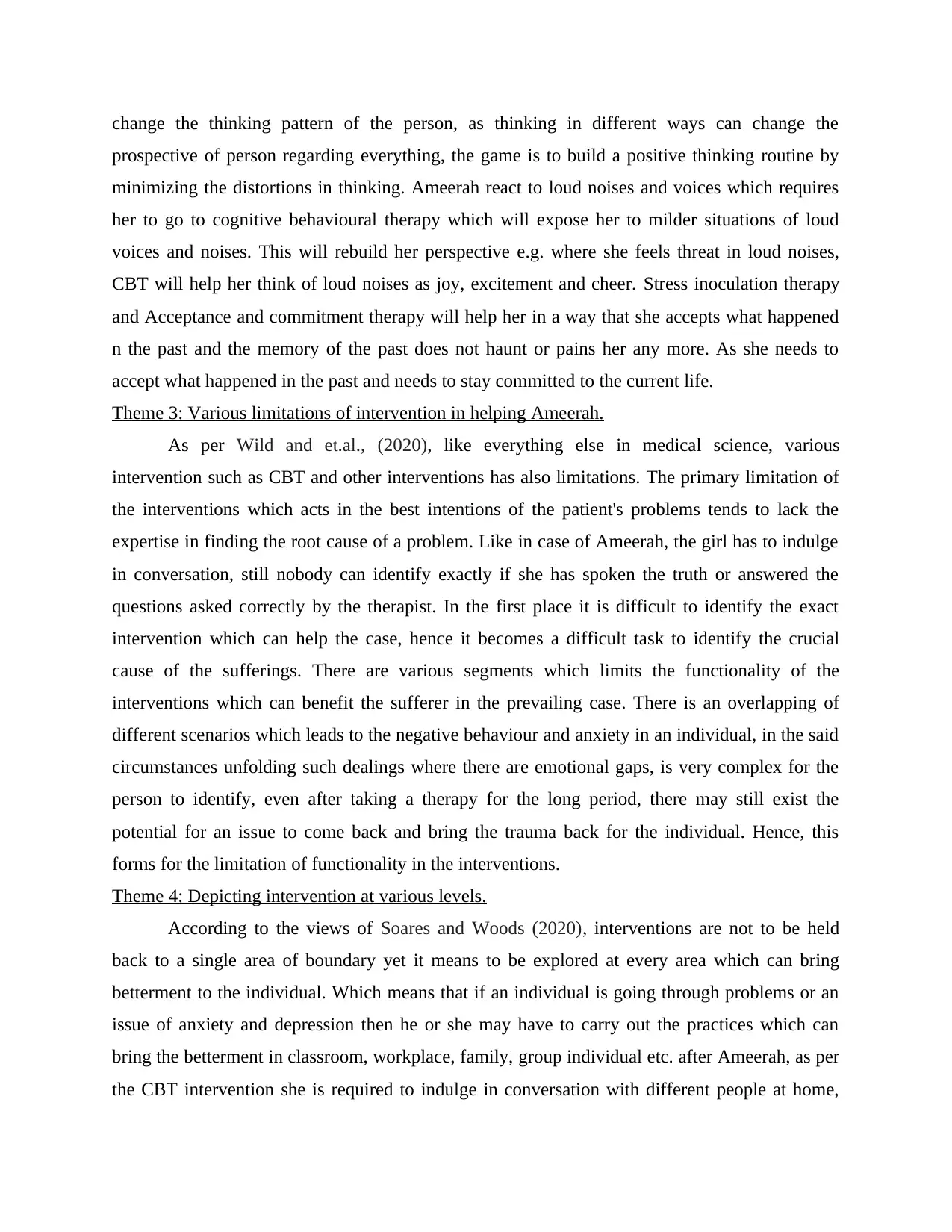
change the thinking pattern of the person, as thinking in different ways can change the
prospective of person regarding everything, the game is to build a positive thinking routine by
minimizing the distortions in thinking. Ameerah react to loud noises and voices which requires
her to go to cognitive behavioural therapy which will expose her to milder situations of loud
voices and noises. This will rebuild her perspective e.g. where she feels threat in loud noises,
CBT will help her think of loud noises as joy, excitement and cheer. Stress inoculation therapy
and Acceptance and commitment therapy will help her in a way that she accepts what happened
n the past and the memory of the past does not haunt or pains her any more. As she needs to
accept what happened in the past and needs to stay committed to the current life.
Theme 3: Various limitations of intervention in helping Ameerah.
As per Wild and et.al., (2020), like everything else in medical science, various
intervention such as CBT and other interventions has also limitations. The primary limitation of
the interventions which acts in the best intentions of the patient's problems tends to lack the
expertise in finding the root cause of a problem. Like in case of Ameerah, the girl has to indulge
in conversation, still nobody can identify exactly if she has spoken the truth or answered the
questions asked correctly by the therapist. In the first place it is difficult to identify the exact
intervention which can help the case, hence it becomes a difficult task to identify the crucial
cause of the sufferings. There are various segments which limits the functionality of the
interventions which can benefit the sufferer in the prevailing case. There is an overlapping of
different scenarios which leads to the negative behaviour and anxiety in an individual, in the said
circumstances unfolding such dealings where there are emotional gaps, is very complex for the
person to identify, even after taking a therapy for the long period, there may still exist the
potential for an issue to come back and bring the trauma back for the individual. Hence, this
forms for the limitation of functionality in the interventions.
Theme 4: Depicting intervention at various levels.
According to the views of Soares and Woods (2020), interventions are not to be held
back to a single area of boundary yet it means to be explored at every area which can bring
betterment to the individual. Which means that if an individual is going through problems or an
issue of anxiety and depression then he or she may have to carry out the practices which can
bring the betterment in classroom, workplace, family, group individual etc. after Ameerah, as per
the CBT intervention she is required to indulge in conversation with different people at home,
prospective of person regarding everything, the game is to build a positive thinking routine by
minimizing the distortions in thinking. Ameerah react to loud noises and voices which requires
her to go to cognitive behavioural therapy which will expose her to milder situations of loud
voices and noises. This will rebuild her perspective e.g. where she feels threat in loud noises,
CBT will help her think of loud noises as joy, excitement and cheer. Stress inoculation therapy
and Acceptance and commitment therapy will help her in a way that she accepts what happened
n the past and the memory of the past does not haunt or pains her any more. As she needs to
accept what happened in the past and needs to stay committed to the current life.
Theme 3: Various limitations of intervention in helping Ameerah.
As per Wild and et.al., (2020), like everything else in medical science, various
intervention such as CBT and other interventions has also limitations. The primary limitation of
the interventions which acts in the best intentions of the patient's problems tends to lack the
expertise in finding the root cause of a problem. Like in case of Ameerah, the girl has to indulge
in conversation, still nobody can identify exactly if she has spoken the truth or answered the
questions asked correctly by the therapist. In the first place it is difficult to identify the exact
intervention which can help the case, hence it becomes a difficult task to identify the crucial
cause of the sufferings. There are various segments which limits the functionality of the
interventions which can benefit the sufferer in the prevailing case. There is an overlapping of
different scenarios which leads to the negative behaviour and anxiety in an individual, in the said
circumstances unfolding such dealings where there are emotional gaps, is very complex for the
person to identify, even after taking a therapy for the long period, there may still exist the
potential for an issue to come back and bring the trauma back for the individual. Hence, this
forms for the limitation of functionality in the interventions.
Theme 4: Depicting intervention at various levels.
According to the views of Soares and Woods (2020), interventions are not to be held
back to a single area of boundary yet it means to be explored at every area which can bring
betterment to the individual. Which means that if an individual is going through problems or an
issue of anxiety and depression then he or she may have to carry out the practices which can
bring the betterment in classroom, workplace, family, group individual etc. after Ameerah, as per
the CBT intervention she is required to indulge in conversation with different people at home,
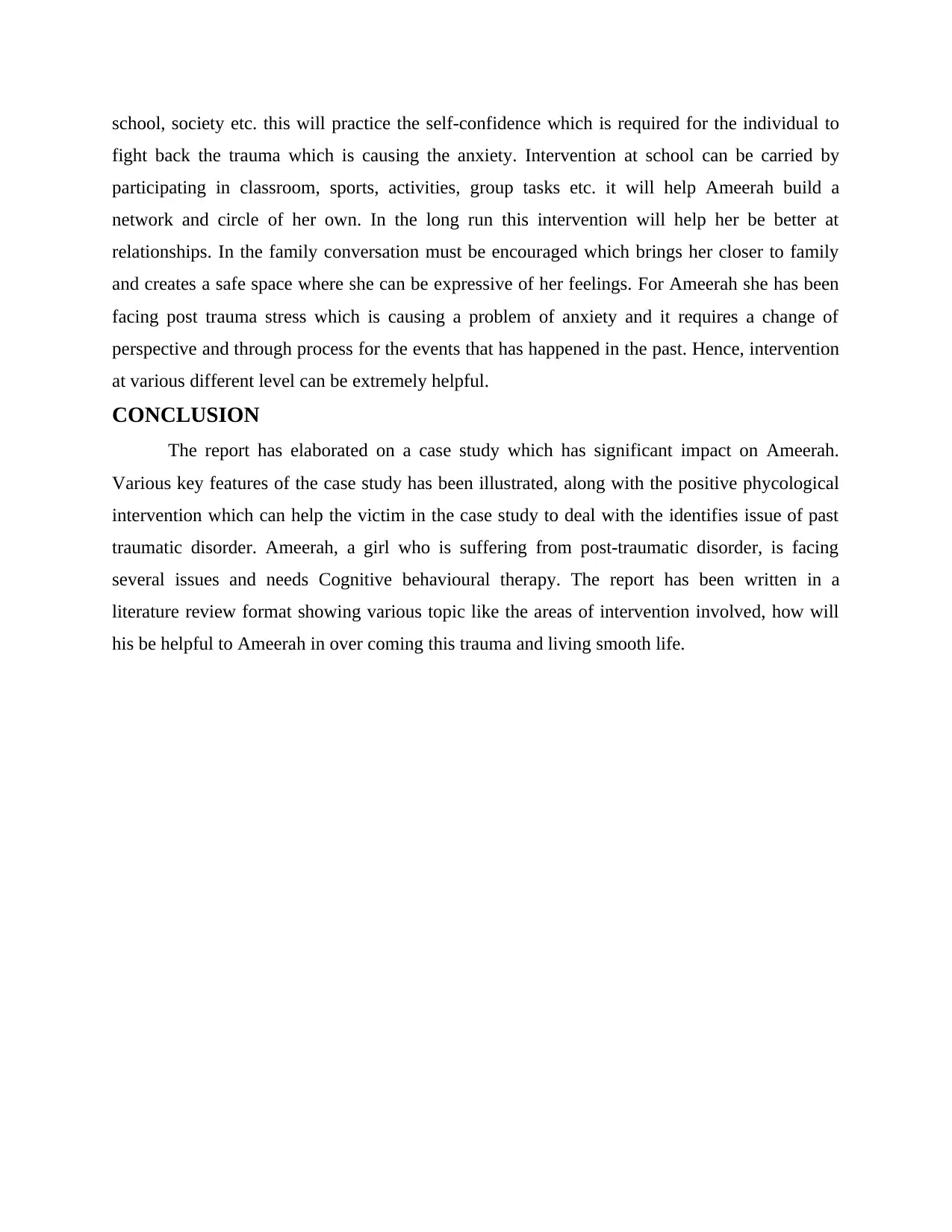
school, society etc. this will practice the self-confidence which is required for the individual to
fight back the trauma which is causing the anxiety. Intervention at school can be carried by
participating in classroom, sports, activities, group tasks etc. it will help Ameerah build a
network and circle of her own. In the long run this intervention will help her be better at
relationships. In the family conversation must be encouraged which brings her closer to family
and creates a safe space where she can be expressive of her feelings. For Ameerah she has been
facing post trauma stress which is causing a problem of anxiety and it requires a change of
perspective and through process for the events that has happened in the past. Hence, intervention
at various different level can be extremely helpful.
CONCLUSION
The report has elaborated on a case study which has significant impact on Ameerah.
Various key features of the case study has been illustrated, along with the positive phycological
intervention which can help the victim in the case study to deal with the identifies issue of past
traumatic disorder. Ameerah, a girl who is suffering from post-traumatic disorder, is facing
several issues and needs Cognitive behavioural therapy. The report has been written in a
literature review format showing various topic like the areas of intervention involved, how will
his be helpful to Ameerah in over coming this trauma and living smooth life.
fight back the trauma which is causing the anxiety. Intervention at school can be carried by
participating in classroom, sports, activities, group tasks etc. it will help Ameerah build a
network and circle of her own. In the long run this intervention will help her be better at
relationships. In the family conversation must be encouraged which brings her closer to family
and creates a safe space where she can be expressive of her feelings. For Ameerah she has been
facing post trauma stress which is causing a problem of anxiety and it requires a change of
perspective and through process for the events that has happened in the past. Hence, intervention
at various different level can be extremely helpful.
CONCLUSION
The report has elaborated on a case study which has significant impact on Ameerah.
Various key features of the case study has been illustrated, along with the positive phycological
intervention which can help the victim in the case study to deal with the identifies issue of past
traumatic disorder. Ameerah, a girl who is suffering from post-traumatic disorder, is facing
several issues and needs Cognitive behavioural therapy. The report has been written in a
literature review format showing various topic like the areas of intervention involved, how will
his be helpful to Ameerah in over coming this trauma and living smooth life.
⊘ This is a preview!⊘
Do you want full access?
Subscribe today to unlock all pages.

Trusted by 1+ million students worldwide
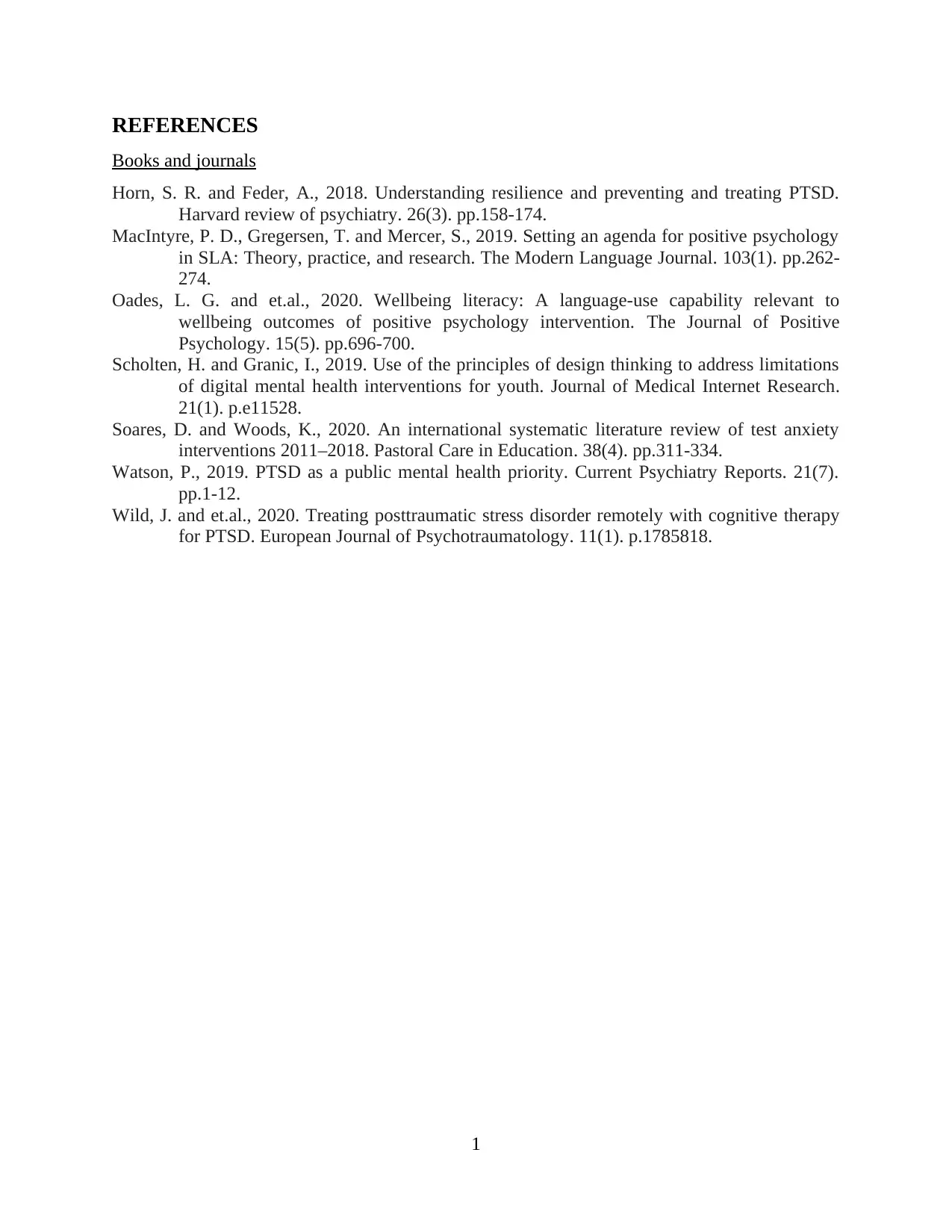
REFERENCES
Books and journals
Horn, S. R. and Feder, A., 2018. Understanding resilience and preventing and treating PTSD.
Harvard review of psychiatry. 26(3). pp.158-174.
MacIntyre, P. D., Gregersen, T. and Mercer, S., 2019. Setting an agenda for positive psychology
in SLA: Theory, practice, and research. The Modern Language Journal. 103(1). pp.262-
274.
Oades, L. G. and et.al., 2020. Wellbeing literacy: A language-use capability relevant to
wellbeing outcomes of positive psychology intervention. The Journal of Positive
Psychology. 15(5). pp.696-700.
Scholten, H. and Granic, I., 2019. Use of the principles of design thinking to address limitations
of digital mental health interventions for youth. Journal of Medical Internet Research.
21(1). p.e11528.
Soares, D. and Woods, K., 2020. An international systematic literature review of test anxiety
interventions 2011–2018. Pastoral Care in Education. 38(4). pp.311-334.
Watson, P., 2019. PTSD as a public mental health priority. Current Psychiatry Reports. 21(7).
pp.1-12.
Wild, J. and et.al., 2020. Treating posttraumatic stress disorder remotely with cognitive therapy
for PTSD. European Journal of Psychotraumatology. 11(1). p.1785818.
1
Books and journals
Horn, S. R. and Feder, A., 2018. Understanding resilience and preventing and treating PTSD.
Harvard review of psychiatry. 26(3). pp.158-174.
MacIntyre, P. D., Gregersen, T. and Mercer, S., 2019. Setting an agenda for positive psychology
in SLA: Theory, practice, and research. The Modern Language Journal. 103(1). pp.262-
274.
Oades, L. G. and et.al., 2020. Wellbeing literacy: A language-use capability relevant to
wellbeing outcomes of positive psychology intervention. The Journal of Positive
Psychology. 15(5). pp.696-700.
Scholten, H. and Granic, I., 2019. Use of the principles of design thinking to address limitations
of digital mental health interventions for youth. Journal of Medical Internet Research.
21(1). p.e11528.
Soares, D. and Woods, K., 2020. An international systematic literature review of test anxiety
interventions 2011–2018. Pastoral Care in Education. 38(4). pp.311-334.
Watson, P., 2019. PTSD as a public mental health priority. Current Psychiatry Reports. 21(7).
pp.1-12.
Wild, J. and et.al., 2020. Treating posttraumatic stress disorder remotely with cognitive therapy
for PTSD. European Journal of Psychotraumatology. 11(1). p.1785818.
1
1 out of 7
Related Documents
Your All-in-One AI-Powered Toolkit for Academic Success.
+13062052269
info@desklib.com
Available 24*7 on WhatsApp / Email
![[object Object]](/_next/static/media/star-bottom.7253800d.svg)
Unlock your academic potential
Copyright © 2020–2025 A2Z Services. All Rights Reserved. Developed and managed by ZUCOL.




